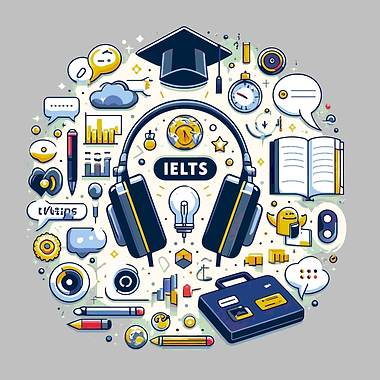

National Accreditation Authority for Translators and Interpreters (NAATI)


IELTS
The IELTS (International English Language Testing System) exam is a standardized test that assesses the English language proficiency of individuals who wish to study or work in environments where English is the language of communication. Recognized globally by universities, employers, and immigration authorities, it provides a reliable measure of a test-taker’s ability in four key language skills: listening, reading, writing, and speaking.
Academic vs. General versions
The exam is available in two versions:
- Academic, for those planning to pursue higher education or professional registration.
- General Training, for those migrating to English-speaking countries or taking up non-academic training or work experience.
Test takers are evaluated on a band scale from 1 to 9 in each of the four sections, with an overall score that is the average of these four parts.

Prepration for IELTS
Preparation for the IELTS exam involves familiarizing oneself with the test format, practicing each language skill, and understanding the assessment criteria. A range of official and unofficial resources is available to aid in this preparation. Success in the IELTS exam opens doors to international academic and professional opportunities, making it a crucial step for many in achieving their global aspirations.
IELTS Speaking Module
The IELTS Speaking exam is a key component of the IELTS test, designed to assess your English-speaking skills in a realistic and structured conversation. It applies to both the Academic and General Training versions of the test. Here’s a breakdown of what it entails:
Format
The Speaking test is a face-to-face interview with a certified examiner and lasts for 11-14 minutes, consisting of three parts:
-
Introduction and Interview (4-5 minutes)
-
The examiner introduces themselves and verifies your identity.
-
You answer general questions about yourself, your family, your work, your education, and your interests. This part aims to make you feel comfortable while speaking English.
-
-
Long Turn (3-4 minutes)
-
You receive a task card that asks you to talk about a particular topic.
-
You have one minute to prepare your talk, and then you speak for 1-2 minutes on the topic.
-
The examiner may ask you one or two questions on the same topic to conclude this part.
-
-
Discussion (4-5 minutes)
-
The examiner asks further questions related to the topic in Part 2. These questions are designed to allow you to discuss more abstract ideas and issues.
-
This part assesses your ability to express and justify opinions and to analyze, discuss, and speculate about issues.
-
Scoring
Your performance is scored based on four criteria:
-
Fluency and Coherence: The ability to talk with normal speed without long pauses and logically connect ideas.
-
Lexical Resource: The range of vocabulary you use and how appropriately you use it.
-
Grammatical Range and Accuracy: The range and correct use of grammar structures.
-
Pronunciation: The ability to be understood, including the accurate production of sounds, word stress, and intonation patterns.
Tips for Success
-
Practice speaking English regularly in varied situations.
-
Record yourself speaking on different topics to evaluate your performance.
-
Expand your vocabulary on a wide range of subjects.
-
Engage in conversations that require expressing opinions and arguments.
-
Listen to native speakers and mimic their way of speaking to improve your fluency and pronunciation.
The IELTS Speaking exam is designed to replicate a natural and comfortable environment for test-takers to demonstrate their spoken English abilities effectively. Preparation and practice are key to achieving a high score in this section.

Specific phrases in the IELTS Speaking test
Using specific phrases in the IELTS Speaking test can help articulate your thoughts more clearly and demonstrate your language proficiency. Here's a summary of useful phrases categorized by different parts of the speaking exam:
Part 1: Introduction and Interview
-
Expressing likes and dislikes: "I'm particularly fond of…" / "I have a preference for…" / "I'm not so keen on…"
-
Talking about habits: "I tend to…" / "I usually…" / "Occasionally, I will…"
-
Describing routines: "My typical day involves…" / "I regularly…" / "Once in a while, I…"
Part 2: Long Turn
-
Starting your response: "Let me tell you about…" / "I'd like to talk about…"
-
Explaining a point: "What I mean to say is…" / "To put it another way…"
-
Adding information: "In addition to this…" / "Furthermore…" / "Moreover…"
-
Showing contrast: "However…" / "On the other hand…" / "Conversely…"
-
Concluding: "To sum up…" / "In conclusion…" / "To wrap things up…"
Part 3: Discussion
-
Expressing opinions: "In my opinion…" / "I believe that…" / "From my perspective…"
-
Agreeing: "I completely agree because…" / "Exactly, I also think that…"
-
Disagreeing: "I see your point, but…" / "I'm not sure I agree because…"
-
Speculating: "It might be that…" / "There's a possibility that…" / "It could be the case that…"
-
Comparing and contrasting: "Compared to…" / "Unlike…" / "Whereas…"
General Strategies
-
Asking for clarification: "Could you please clarify what you mean by…?" / "I'm sorry, could you explain…?"
-
Buying time to think: "That's an interesting question. Let me think about that for a moment."
-
Correcting yourself: "What I meant to say was…" / "Let me rephrase that…"
Incorporating these phrases into your responses can help you sound more natural and fluent during the speaking test. Practice using them in context to become comfortable and to enhance your overall communication effectiveness.